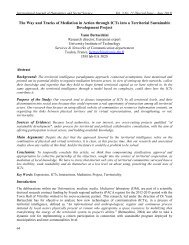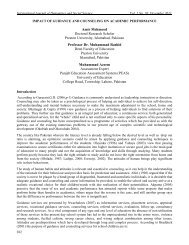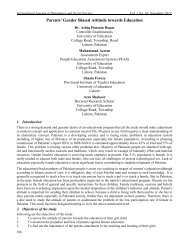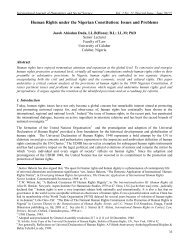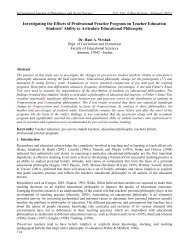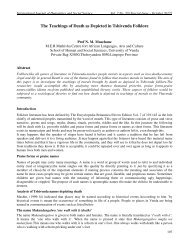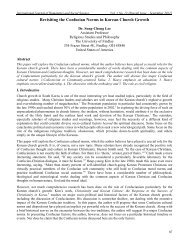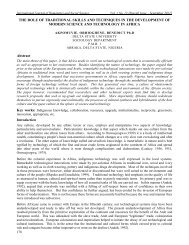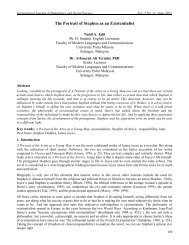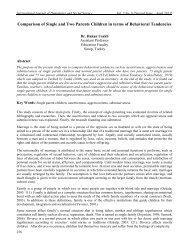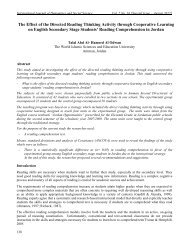Gender Influence on Access to Innovation Resources in Nigeria
Gender Influence on Access to Innovation Resources in Nigeria
Gender Influence on Access to Innovation Resources in Nigeria
Create successful ePaper yourself
Turn your PDF publications into a flip-book with our unique Google optimized e-Paper software.
Internati<strong>on</strong>al Journal of Humanities and Social Science Vol. 3 No. 1; January 2013<br />
<str<strong>on</strong>g>Gender</str<strong>on</strong>g> <str<strong>on</strong>g>Influence</str<strong>on</strong>g> <strong>on</strong> <strong>Access</strong> <strong>to</strong> Innovati<strong>on</strong> <strong>Resources</strong> <strong>in</strong> <strong>Nigeria</strong><br />
Ighomereho, O. Salome<br />
Department of Ec<strong>on</strong>omics and Bus<strong>in</strong>ess Studies<br />
Redeemer’s University<br />
Ogun State, <strong>Nigeria</strong>.<br />
Agbalajobi, T. Damilola<br />
Department of Political Science<br />
Obafemi Awolowo University (OAU)<br />
Ile-Ife, Osun State, <strong>Nigeria</strong>.<br />
Edegwa, K. Sunday<br />
Department of Bus<strong>in</strong>ess Adm<strong>in</strong>istrati<strong>on</strong><br />
University of Lagos<br />
Lagos, <strong>Nigeria</strong>.<br />
Abstract<br />
Studies have <strong>in</strong>dicated that men are more <strong>in</strong>novative than women <strong>in</strong> every aspect of bus<strong>in</strong>ess. In an attempt <strong>to</strong><br />
unravel the reas<strong>on</strong>s for such a scenario, this study <strong>in</strong>vestigated empirically gender <strong>in</strong>fluence <strong>on</strong> access <strong>to</strong><br />
<strong>in</strong>novati<strong>on</strong> resources am<strong>on</strong>g women and men-owned Small and Medium- sized Enterprises (SMEs) <strong>in</strong> Lagos State,<br />
<strong>Nigeria</strong>. Five <strong>in</strong>novati<strong>on</strong> resources which <strong>in</strong>clude educati<strong>on</strong>, f<strong>in</strong>ance, skilled workforce, extensi<strong>on</strong> and support<br />
services and partnership were exam<strong>in</strong>ed <strong>in</strong> relati<strong>on</strong> <strong>to</strong> gender. The data collected via questi<strong>on</strong>naires were<br />
analyzed us<strong>in</strong>g percentages, Analysis of Variance (ANOVA) and regressi<strong>on</strong> analysis. The results <strong>in</strong>dicated that<br />
women are discrim<strong>in</strong>ated aga<strong>in</strong>st <strong>in</strong> access <strong>to</strong> f<strong>in</strong>ance and skilled workforce but are not discrim<strong>in</strong>ated aga<strong>in</strong>st <strong>in</strong><br />
access <strong>to</strong> educati<strong>on</strong>, extensi<strong>on</strong> and support services and partnership. It was also found that access <strong>to</strong> four of the<br />
<strong>in</strong>novati<strong>on</strong> resources identified <strong>in</strong> the study and gender have significant impact <strong>on</strong> <strong>in</strong>novati<strong>on</strong> performance.<br />
<strong>Access</strong> <strong>to</strong> extensi<strong>on</strong> and support service has no significant impact. It was therefore recommended that policies<br />
and schemes target<strong>in</strong>g SMEs especially with respect <strong>to</strong> f<strong>in</strong>ance should be gender friendly so as <strong>to</strong> <strong>in</strong>vigorate the<br />
otherwise dormant potential <strong>in</strong> women <strong>to</strong> <strong>in</strong>novate.<br />
Keywords: <str<strong>on</strong>g>Gender</str<strong>on</strong>g> <strong>in</strong>fluence, women, men, SMEs, <strong>in</strong>novati<strong>on</strong> resources, discrim<strong>in</strong>ati<strong>on</strong><br />
1. Introducti<strong>on</strong><br />
Globally, Small and Medium-sized Enterprises (SMEs) c<strong>on</strong>stitute the majority of enterprises, and as a result, they<br />
face the most severe competiti<strong>on</strong>. In order <strong>to</strong> ga<strong>in</strong> competitive advantage and survive, they have <strong>to</strong> be <strong>in</strong>novative<br />
(Ramadani and Gerguri, 2011). Nati<strong>on</strong>s worldwide are driv<strong>in</strong>g <strong>in</strong>novati<strong>on</strong> <strong>in</strong> their SMEs sec<strong>to</strong>r (NTWG 2009) by<br />
encourag<strong>in</strong>g them <strong>to</strong> be <strong>in</strong>novative. This is necessary because <strong>in</strong>novati<strong>on</strong> impacts positively <strong>on</strong> performance and<br />
growth. In recent years, the c<strong>on</strong>necti<strong>on</strong> between <strong>in</strong>novati<strong>on</strong> and gender has attracted <strong>in</strong>creased <strong>in</strong>terest am<strong>on</strong>g<br />
researchers (Crowden, 2003; K<strong>in</strong>giri, 2010; Johanss<strong>on</strong> and L<strong>in</strong>dberg, 2011; Danilda and Thorslund, 2011). It has<br />
been observed that women are few as <strong>in</strong>nova<strong>to</strong>rs compared <strong>to</strong> men and that men-dom<strong>in</strong>ated occupati<strong>on</strong>s are more<br />
<strong>in</strong>novative than women-dom<strong>in</strong>ated <strong>on</strong>es. Nyberg (2009) stated that be<strong>in</strong>g an <strong>in</strong>nova<strong>to</strong>r is not regarded as a<br />
fem<strong>in</strong><strong>in</strong>e trait s<strong>in</strong>ce the image of the <strong>in</strong>nova<strong>to</strong>r is not easily compatible with the image of be<strong>in</strong>g a woman.<br />
Sandi<strong>to</strong>v and Verspagen (2011) reported a study by Koell<strong>in</strong>ger (2008) which found that <strong>in</strong>novative entrepreneurs<br />
are mostly males. This has brought about segregati<strong>on</strong> and hierarchical noti<strong>on</strong>s of gender, c<strong>on</strong>struct<strong>in</strong>g men and<br />
certa<strong>in</strong> mascul<strong>in</strong>ities as be<strong>in</strong>g more relevant <strong>to</strong> <strong>in</strong>novati<strong>on</strong> and growth than women and certa<strong>in</strong> fem<strong>in</strong><strong>in</strong>ities.<br />
216
© Centre for Promot<strong>in</strong>g Ideas, USA www.ijhssnet.com<br />
Blake and Hans<strong>on</strong> (2005) highlighted how gender is a relevant fac<strong>to</strong>r <strong>in</strong> such an appraisal, primarily prioritiz<strong>in</strong>g<br />
men as <strong>in</strong>nova<strong>to</strong>rs and envisi<strong>on</strong>ed mascul<strong>in</strong>e areas of <strong>in</strong>novati<strong>on</strong>. Nahl<strong>in</strong>der, (2010) argued that the<br />
<strong>in</strong>novativeness of women is hampered by low self-c<strong>on</strong>fidence and low prioritizati<strong>on</strong> of work issues over family or<br />
household issues. In another view, Crowden (2003) stated that “men are more likely <strong>to</strong> radically <strong>in</strong>novate than<br />
women because of their pers<strong>on</strong>al and social characteristics, thus bus<strong>in</strong>ess cycles <strong>in</strong>itiated by radical <strong>in</strong>novati<strong>on</strong>s<br />
can be deemed male-based”. In additi<strong>on</strong>, K<strong>in</strong>giri, (2010) cit<strong>in</strong>g World Bank, FAO and IFAD stated that gender<br />
<strong>in</strong>equalities occur <strong>in</strong> <strong>in</strong>novati<strong>on</strong> due <strong>to</strong> unequal or c<strong>on</strong>stra<strong>in</strong>ed access <strong>to</strong> resources and new technologies and<br />
access <strong>to</strong> <strong>in</strong>formati<strong>on</strong>, poor social networks, and literacy level.<br />
The <strong>in</strong>novati<strong>on</strong> studies, however, have not taken <strong>in</strong><strong>to</strong> account the views of women about their access <strong>to</strong> <strong>in</strong>novati<strong>on</strong><br />
resources and have not c<strong>on</strong>sidered empirically if access <strong>to</strong> <strong>in</strong>novati<strong>on</strong> resources could be <strong>on</strong>e of the reas<strong>on</strong>s why<br />
women and men’s c<strong>on</strong>tributi<strong>on</strong>s <strong>to</strong> <strong>in</strong>novati<strong>on</strong> differ. In <strong>Nigeria</strong>, the federal government has been striv<strong>in</strong>g <strong>to</strong><br />
promote equality of men and women <strong>in</strong> accordance with c<strong>on</strong>stituti<strong>on</strong>al provisi<strong>on</strong>s. This commitment was<br />
exemplified by the sign<strong>in</strong>g of the Nati<strong>on</strong>al Policy <strong>on</strong> Women <strong>in</strong> July 2000 after the failures of previous<br />
adm<strong>in</strong>istrati<strong>on</strong>s. The policy provides an opportunity and anchor for present and future <strong>in</strong>itiatives <strong>to</strong> address the<br />
barriers that limit the full participati<strong>on</strong> of <strong>Nigeria</strong>n women <strong>in</strong> various aspects of life. Also, government at various<br />
times and at various levels has <strong>in</strong>itiated and implemented credit schemes <strong>to</strong> empower marg<strong>in</strong>alized entrepreneurs<br />
like women (Eriki and Okafor, 2003; Nwoye, 2011). The efforts of the government <strong>to</strong> promote gender equality<br />
and women empowerment is complemented by the work of vibrant NGOs, women groups and coaliti<strong>on</strong>s that have<br />
sprung up <strong>to</strong> address the needs of women. <str<strong>on</strong>g>Gender</str<strong>on</strong>g> equality works <strong>to</strong>ward end<strong>in</strong>g discrim<strong>in</strong>ati<strong>on</strong> by provid<strong>in</strong>g<br />
equal opportunities or ensur<strong>in</strong>g equality of c<strong>on</strong>diti<strong>on</strong>s for men and women. Equality is c<strong>on</strong>sidered <strong>to</strong> mean that<br />
every<strong>on</strong>e receives the same benefit, share or treatment regardless of their situati<strong>on</strong> and circumstances. Therefore,<br />
the purpose of this paper is <strong>to</strong> advance knowledge as <strong>to</strong> the relati<strong>on</strong>ship between access <strong>to</strong> resources and<br />
<strong>in</strong>novative ability <strong>in</strong> a country where efforts are be<strong>in</strong>g made <strong>to</strong> promote gender equality. This has important<br />
implicati<strong>on</strong>s for the understand<strong>in</strong>g of the resources that promote and drive <strong>in</strong>novati<strong>on</strong>. The specific objectives that<br />
motivated this study <strong>in</strong>clude:<br />
i. To ascerta<strong>in</strong> if men entrepreneurs are actually more <strong>in</strong>novative than women entrepreneurs <strong>in</strong> <strong>Nigeria</strong>.<br />
ii. To <strong>in</strong>vestigate if disparities exist between women and men entrepreneurs <strong>in</strong> access<strong>in</strong>g <strong>in</strong>novati<strong>on</strong><br />
resources <strong>in</strong> <strong>Nigeria</strong>.<br />
iii. To determ<strong>in</strong>e if gender has a higher significant impact <strong>on</strong> <strong>in</strong>novati<strong>on</strong> performance than <strong>in</strong>novati<strong>on</strong><br />
resources.<br />
The follow<strong>in</strong>g hypotheses were exam<strong>in</strong>ed:<br />
i. Ho 1 : Women entrepreneurs have equal access <strong>to</strong> all <strong>in</strong>novati<strong>on</strong> resources as men entrepreneurs <strong>in</strong><br />
<strong>Nigeria</strong>.<br />
ii. Ho 2 : <str<strong>on</strong>g>Gender</str<strong>on</strong>g> has a higher significant impact <strong>on</strong> <strong>in</strong>novati<strong>on</strong> performance than <strong>in</strong>novati<strong>on</strong> resources.<br />
2. Literature Review<br />
2.1 C<strong>on</strong>ceptualiz<strong>in</strong>g Innovati<strong>on</strong><br />
The c<strong>on</strong>cept of <strong>in</strong>novati<strong>on</strong> has been def<strong>in</strong>ed <strong>in</strong> various ways. Ramadani and Gerguri (2011) def<strong>in</strong>ed <strong>in</strong>novati<strong>on</strong> as<br />
“a process of transform<strong>in</strong>g new ideas and new knowledge <strong>in</strong><strong>to</strong> new products and services”. In the views of<br />
Baregheh et al (2009) <strong>in</strong>novati<strong>on</strong> is a multi-stage process whereby organizati<strong>on</strong>s transform ideas <strong>in</strong><strong>to</strong><br />
new/improved products, services or processes <strong>in</strong> order <strong>to</strong> advance, compete and differentiate themselves<br />
successfully <strong>in</strong> the marketplace. In dist<strong>in</strong>guish<strong>in</strong>g between creativity and <strong>in</strong>novati<strong>on</strong>, Weihrich and Ko<strong>on</strong>tz (2005)<br />
def<strong>in</strong>ed creativity as “the ability and power <strong>to</strong> develop new ideas while <strong>in</strong>novati<strong>on</strong> is the use of these ideas”.<br />
Adeyeye (2008) differentiated between <strong>in</strong>venti<strong>on</strong> and <strong>in</strong>novati<strong>on</strong> by def<strong>in</strong><strong>in</strong>g <strong>in</strong>venti<strong>on</strong> as “the act of develop<strong>in</strong>g,<br />
design<strong>in</strong>g or creat<strong>in</strong>g someth<strong>in</strong>g that has not existed before while <strong>in</strong>novati<strong>on</strong> is <strong>in</strong>venti<strong>on</strong> and/or applicati<strong>on</strong> of<br />
new knowledge <strong>in</strong> a particular area”. This means that <strong>in</strong>venti<strong>on</strong>s can be seen as <strong>in</strong>novati<strong>on</strong>s but <strong>in</strong>novati<strong>on</strong>s are<br />
not necessarily <strong>in</strong>venti<strong>on</strong>s because <strong>in</strong>novati<strong>on</strong>s may be a l<strong>on</strong>g established ideas or products <strong>in</strong>volv<strong>in</strong>g a new<br />
applicati<strong>on</strong>. Innovati<strong>on</strong> therefore can be c<strong>on</strong>ceptualized as the development and/or applicati<strong>on</strong> of new products,<br />
methods of producti<strong>on</strong>, processes and services.<br />
217
Internati<strong>on</strong>al Journal of Humanities and Social Science Vol. 3 No. 1; January 2013<br />
2.2 Why Innovate <strong>in</strong> Bus<strong>in</strong>ess?<br />
Innovati<strong>on</strong> ensures the susta<strong>in</strong>ability of a bus<strong>in</strong>ess. Successful SMEs can <strong>on</strong>ly survive <strong>in</strong> or shape their bus<strong>in</strong>ess<br />
envir<strong>on</strong>ment by be<strong>in</strong>g at the forefr<strong>on</strong>t of <strong>in</strong>novativeness. The <strong>in</strong>creas<strong>in</strong>g dynamism of the market and the<br />
opportunities and threats unleashed by the globalizati<strong>on</strong> of markets has made <strong>in</strong>novative behaviour a critical<br />
determ<strong>in</strong>ant of value creati<strong>on</strong>. These developments have created urgent need for SMEs <strong>to</strong> be <strong>in</strong>novative<br />
(Nkamnebe, 2011). Innovati<strong>on</strong> <strong>in</strong> new product is am<strong>on</strong>g the most critical activities for the success and even the<br />
survival of organizati<strong>on</strong>s (McNally and Schmidt, 2011). In order for a bus<strong>in</strong>ess <strong>to</strong> ma<strong>in</strong>ta<strong>in</strong> its market share, it<br />
must be <strong>in</strong>novative. Innovati<strong>on</strong> imposes itself as a determ<strong>in</strong>ant fac<strong>to</strong>r of bus<strong>in</strong>ess success (Ch<strong>in</strong><strong>on</strong>ye, 2002;<br />
Moreira et al, 2012). A bus<strong>in</strong>ess's ability <strong>to</strong> create and ma<strong>in</strong>ta<strong>in</strong> c<strong>on</strong>sumers is directly dependent up<strong>on</strong> its ability <strong>to</strong><br />
produce <strong>in</strong>novative products and/or services.<br />
Isolat<strong>in</strong>g the benefits of the various types of <strong>in</strong>novati<strong>on</strong>, Omach<strong>on</strong>u and E<strong>in</strong>spruch (2010) stated that<br />
technological <strong>in</strong>novati<strong>on</strong>s present vast opportunities for enhanc<strong>in</strong>g <strong>in</strong>ternal producti<strong>on</strong> processes for goods and<br />
services. Product <strong>in</strong>novati<strong>on</strong> which is the <strong>in</strong>troducti<strong>on</strong> of new types of goods and services <strong>to</strong> the market is<br />
essential <strong>to</strong> the life of any organizati<strong>on</strong> s<strong>in</strong>ce they provide the most obvious means for generat<strong>in</strong>g <strong>in</strong>cremental<br />
revenues. Process <strong>in</strong>novati<strong>on</strong>, improves <strong>in</strong>ternal capabilities and quality. Ramadani and Gerguri (2011) reported<br />
that <strong>in</strong> a study carried out <strong>in</strong> April 2010 us<strong>in</strong>g 119 SMEs, it was found that the importance and benefits of<br />
<strong>in</strong>novati<strong>on</strong> are improvement <strong>in</strong> the quality of products and services offered <strong>to</strong> cus<strong>to</strong>mers (27% of the<br />
resp<strong>on</strong>dents), creati<strong>on</strong> of better c<strong>on</strong>diti<strong>on</strong>s at work (18% of the resp<strong>on</strong>dents), ma<strong>in</strong>tenance of the exist<strong>in</strong>g positi<strong>on</strong><br />
<strong>in</strong> the market (17% of the resp<strong>on</strong>dents), enter<strong>in</strong>g new markets (13% of the resp<strong>on</strong>dents), creat<strong>in</strong>g flexibility at<br />
work (9% of the resp<strong>on</strong>dents), improv<strong>in</strong>g the ecological envir<strong>on</strong>ment and diversificati<strong>on</strong> of product range (2% of<br />
the resp<strong>on</strong>dents). Apart from the benefits of <strong>in</strong>novati<strong>on</strong> <strong>to</strong> the enterprise, it is also a <strong>to</strong>ol for creat<strong>in</strong>g wealth and<br />
ec<strong>on</strong>omic growth which <strong>in</strong> turn leads <strong>to</strong> ec<strong>on</strong>omic development (Danilda and Thorslund, 2011). The emergence of<br />
the Eastern Asian Tigers provides str<strong>on</strong>g proof of the power of <strong>in</strong>novati<strong>on</strong> <strong>to</strong> br<strong>in</strong>g about development. Their<br />
rapid growth owes much of their successes <strong>to</strong> the favourably structured <strong>in</strong>novati<strong>on</strong> system of their countries.<br />
Innovati<strong>on</strong> is an <strong>in</strong>creas<strong>in</strong>gly important c<strong>on</strong>tribu<strong>to</strong>r <strong>to</strong> susta<strong>in</strong>able ec<strong>on</strong>omic growth both at the micro-ec<strong>on</strong>omic<br />
and macro-ec<strong>on</strong>omic levels.<br />
2.3 Theoretical/C<strong>on</strong>ceptual Framework<br />
The theory of gender system which describes the power relati<strong>on</strong> between men and women has significant<br />
implicati<strong>on</strong>s for the gendered aspect of <strong>in</strong>novati<strong>on</strong>. It is based <strong>on</strong> two phenomena: segregati<strong>on</strong> (women and men<br />
are segregated by law or by other means <strong>in</strong>clud<strong>in</strong>g <strong>in</strong>formal <strong>on</strong>es) and hierarchisati<strong>on</strong> (the male is the rule and<br />
standard and thereby is more highly valued). This could lead <strong>to</strong> a situati<strong>on</strong> where men-owned bus<strong>in</strong>esses attract<br />
resources more than women-owned bus<strong>in</strong>esses, which off course has implicati<strong>on</strong> for performance accord<strong>in</strong>g <strong>to</strong><br />
resource-based view. The resource-based view is a strategic theory for understand<strong>in</strong>g why some firms outperform<br />
others. It assumes that each firm is a collecti<strong>on</strong> of key resources and capabilities that determ<strong>in</strong>es a firm’s strategy.<br />
With the progress <strong>in</strong> the research <strong>on</strong> resource-based view, it has become clear that the resource-based view<br />
extends bey<strong>on</strong>d the assets of an organisati<strong>on</strong> and reaches <strong>in</strong><strong>to</strong> its capabilities which have more relati<strong>on</strong> with<br />
process and activities (Eisenhardt and Mart<strong>in</strong>, 2000). In additi<strong>on</strong>, the fem<strong>in</strong>ist theory which analyzes issues that<br />
perta<strong>in</strong>s <strong>to</strong> men and women seeks <strong>to</strong> provide an understand<strong>in</strong>g of the nature of gender <strong>in</strong>equality and the<br />
promoti<strong>on</strong> of women’s rights, <strong>in</strong>terests and issues. This theory assumes that women generally experience<br />
subord<strong>in</strong>ati<strong>on</strong> and that the treatment of women <strong>in</strong> relati<strong>on</strong> <strong>to</strong> men has not been equal or fair (Wikipedia, n.d).<br />
These theories sought <strong>to</strong> expla<strong>in</strong> why women have experienced discrim<strong>in</strong>ati<strong>on</strong>, and how this discrim<strong>in</strong>ati<strong>on</strong> has<br />
placed them <strong>in</strong> disadvantaged positi<strong>on</strong>s <strong>in</strong> the stratificati<strong>on</strong> system. As such, access <strong>to</strong> resources is assumed <strong>to</strong><br />
<strong>in</strong>fluence <strong>in</strong>novati<strong>on</strong> performance. The c<strong>on</strong>ceptual framework for this study is depicted <strong>in</strong> figure 1 below:<br />
218
© Centre for Promot<strong>in</strong>g Ideas, USA www.ijhssnet.com<br />
Figure 1: Impact of <str<strong>on</strong>g>Gender</str<strong>on</strong>g> and Innovati<strong>on</strong> <strong>Resources</strong> <strong>on</strong> Innovati<strong>on</strong> Performance<br />
<str<strong>on</strong>g>Gender</str<strong>on</strong>g><br />
Innovati<strong>on</strong><br />
Performance<br />
Innovati<strong>on</strong><br />
<strong>Resources</strong><br />
Educati<strong>on</strong> F<strong>in</strong>ance Skilled<br />
Workforce<br />
Extensi<strong>on</strong> and<br />
Support Services<br />
Partnership<br />
Figure 1 <strong>in</strong>dicates the impact relati<strong>on</strong>ship between gender and <strong>in</strong>novati<strong>on</strong> performance and between <strong>in</strong>novati<strong>on</strong><br />
resources and <strong>in</strong>novati<strong>on</strong> performance. A review of the literature <strong>on</strong> these relati<strong>on</strong>ships is discussed below:<br />
2.3.1 Innovati<strong>on</strong> Performance<br />
Brychan, et al. (2011) described <strong>in</strong>novati<strong>on</strong> performance as statistics that describes the various aspects of<br />
<strong>in</strong>novati<strong>on</strong>. The <strong>in</strong>dica<strong>to</strong>rs they cited <strong>to</strong> measure <strong>in</strong>novati<strong>on</strong> performance are bus<strong>in</strong>ess expenditure <strong>on</strong> research and<br />
development (R&D), patents, new product <strong>in</strong>novati<strong>on</strong>s, and the adopti<strong>on</strong> of advanced manufactur<strong>in</strong>g<br />
technologies. In additi<strong>on</strong>, Ramadani and Gerguri (2011) stated that Joseph Schumpeter identified five <strong>in</strong>novati<strong>on</strong><br />
activities c<strong>on</strong>sist<strong>in</strong>g of <strong>in</strong>troducti<strong>on</strong> of a new product, <strong>in</strong>troducti<strong>on</strong> of a new method of producti<strong>on</strong>, open<strong>in</strong>g new<br />
markets, f<strong>in</strong>d<strong>in</strong>g of appropriate sources of raw materials and establish<strong>in</strong>g a new organizati<strong>on</strong> <strong>in</strong> the <strong>in</strong>dustry.<br />
Innovati<strong>on</strong> performance could also <strong>in</strong>clude new design and packag<strong>in</strong>g of goods and services, new distributi<strong>on</strong><br />
system and new and better sales techniques.<br />
2.3.2 <str<strong>on</strong>g>Gender</str<strong>on</strong>g><br />
The literature <strong>on</strong> gender and <strong>in</strong>novati<strong>on</strong> posits that gender is a significant fac<strong>to</strong>r that affects <strong>in</strong>novati<strong>on</strong><br />
performance. Some authors are of the view that be<strong>in</strong>g an <strong>in</strong>nova<strong>to</strong>r is not an attribute of women because the image<br />
of the <strong>in</strong>nova<strong>to</strong>r is not compatible with the image of be<strong>in</strong>g a woman (Nyberg, 2009). C<strong>on</strong>sequently, men are<br />
assumed <strong>to</strong> be highly <strong>in</strong>novative while women are not (Blake and Hans<strong>on</strong>, 2005).<br />
2.3.3 Innovati<strong>on</strong> <strong>Resources</strong><br />
Innovati<strong>on</strong> holds out the hope of large rewards but it usually requires significant resources either al<strong>on</strong>e or with<br />
others. Innovati<strong>on</strong> resources are assets, facilities or services that propel and drive <strong>in</strong>novati<strong>on</strong>. Accord<strong>in</strong>g <strong>to</strong><br />
Saranga and Be<strong>in</strong>e (2011) <strong>in</strong>novati<strong>on</strong> resources and capabilities have been found <strong>to</strong> be essential <strong>to</strong> climb up the<br />
value cha<strong>in</strong> <strong>in</strong> most <strong>in</strong>dustries. However, development of <strong>in</strong>novati<strong>on</strong> resources and effective deployment of these<br />
resources requires significant <strong>in</strong>vestments <strong>on</strong> a susta<strong>in</strong>ed basis, which is a difficult task for domestic firms <strong>in</strong><br />
many develop<strong>in</strong>g ec<strong>on</strong>omies. Innovati<strong>on</strong> can <strong>on</strong>ly be enhanced <strong>in</strong> an entrepreneur who possesses the fund<br />
necessary <strong>to</strong> test out ideas, is well tra<strong>in</strong>ed <strong>to</strong> br<strong>in</strong>g modern knowledge <strong>to</strong> bear <strong>in</strong> his/her tasks and that can easily<br />
get <strong>in</strong> <strong>to</strong>uch with like-m<strong>in</strong>ded entrepreneurs (Ch<strong>in</strong><strong>on</strong>ye 2002). In this paper, five <strong>in</strong>novati<strong>on</strong> resources that are<br />
relevant <strong>to</strong> the <strong>Nigeria</strong> situati<strong>on</strong> were identified. They <strong>in</strong>clude educati<strong>on</strong>, f<strong>in</strong>ance, skilled workforce, extensi<strong>on</strong> and<br />
support services and partnership.<br />
2.3.4 Innovati<strong>on</strong> and educati<strong>on</strong><br />
Educati<strong>on</strong> is <strong>on</strong>e of the most powerful <strong>in</strong>struments for <strong>in</strong>novativeness (Sandi<strong>to</strong>v and Verspagen (2011).<br />
Individuals (women and men) who are allowed <strong>to</strong> develop their full potential will be creative, engaged and<br />
will<strong>in</strong>g <strong>to</strong> take risks (Danilda and Thorslund, 2011). Educati<strong>on</strong> provides <strong>in</strong>dividuals with the necessary knowledge<br />
and skill <strong>to</strong> be thoughtful, imag<strong>in</strong>ative, creative, resourceful and <strong>in</strong>novative. It is generally believed that women<br />
have less access <strong>to</strong> educati<strong>on</strong>, tend <strong>to</strong> be less experienced and less assertive <strong>to</strong> ga<strong>in</strong> experience and tra<strong>in</strong><strong>in</strong>g and<br />
that they do not have the knowledge, experience and skills necessary <strong>to</strong> spur <strong>in</strong>novative activities.<br />
219
Internati<strong>on</strong>al Journal of Humanities and Social Science Vol. 3 No. 1; January 2013<br />
However, majority of women all over the world <strong>to</strong>day are highly educated. Accord<strong>in</strong>g <strong>to</strong> Nwoye (2011) women<br />
are better educated now than before but the level of educati<strong>on</strong> of the average woman is still low compared <strong>to</strong> men<br />
and this could have significant implicati<strong>on</strong>s for <strong>in</strong>novati<strong>on</strong>.<br />
2.3.5 Innovati<strong>on</strong> and F<strong>in</strong>ance<br />
F<strong>in</strong>ance has been identified as a major challenge <strong>to</strong> SMEs (CBN, 2003; Eriki and Okafor, 2003; Ojo, 2004;<br />
Brychan et al, 2011). There may be good ideas and <strong>in</strong>itiatives but m<strong>on</strong>ey is the vehicle of transformati<strong>on</strong> <strong>in</strong><strong>to</strong><br />
realities. Many <strong>in</strong>novative ideas of bus<strong>in</strong>ess owners die due <strong>to</strong> <strong>in</strong>adequate fund. The <strong>Nigeria</strong>n government hav<strong>in</strong>g<br />
taken access <strong>to</strong> f<strong>in</strong>ance as the most important critical fac<strong>to</strong>r for SME promoti<strong>on</strong> has recently embarked <strong>on</strong> several<br />
SME f<strong>in</strong>anc<strong>in</strong>g schemes and programmes. In review<strong>in</strong>g the SME framework <strong>in</strong> 2000, the Federal government<br />
established the Bank of Industry (BOI). It is an amalgam of the former <strong>Nigeria</strong>n Industrial Development Bank, the<br />
<strong>Nigeria</strong>n Bank for Commerce and Industry and the Nati<strong>on</strong>al Ec<strong>on</strong>omic Rec<strong>on</strong>structi<strong>on</strong> Fund (NERFUND). It was<br />
set up with the pr<strong>in</strong>cipal objective of provid<strong>in</strong>g credit <strong>to</strong> the <strong>in</strong>dustrial sec<strong>to</strong>r, <strong>in</strong>clud<strong>in</strong>g the small and medium<br />
scale enterprises (CBN, 2003).The <strong>Nigeria</strong>n Agricultural Cooperative and Rural Development Bank Limited<br />
(NACRDB) which is an amalgam of the former Peoples Bank of <strong>Nigeria</strong>, <strong>Nigeria</strong>n Agricultural and Cooperative<br />
Bank and the Family Ec<strong>on</strong>omic Advancement Programme (FEAP) was also set up <strong>in</strong> Oc<strong>to</strong>ber 2000, primarily <strong>to</strong><br />
f<strong>in</strong>ance agriculture as well as small and medium enterprises. The Small and Medium Industry Equity Investment<br />
Scheme (SMIEIS) was established <strong>in</strong> 2001. The c<strong>on</strong>cept of SMIEIS <strong>in</strong> <strong>Nigeria</strong> was the <strong>in</strong>itiative of the Central<br />
Bank of <strong>Nigeria</strong> with the voluntary support and efforts of the Bankers’ Committee. The Scheme requires that all<br />
banks <strong>in</strong> <strong>Nigeria</strong> should set aside 10 percent of their profit before tax annually for equity <strong>in</strong>vestments <strong>in</strong> small and<br />
medium <strong>in</strong>dustries. Also, the Small and Medium Enterprise Development Agency (SMEDAN) was established <strong>in</strong><br />
2003 <strong>to</strong> facilitate SMEs access <strong>to</strong> f<strong>in</strong>ance and other resources that will ensure that they c<strong>on</strong>tribute significantly <strong>to</strong><br />
the ec<strong>on</strong>omic development of <strong>Nigeria</strong> (SMEDAN, 2003). These schemes are <strong>in</strong>tended <strong>to</strong> elim<strong>in</strong>ate the burden of<br />
<strong>in</strong>terest and other charges associated with normal bank lend<strong>in</strong>g.<br />
It has also been argued that f<strong>in</strong>ance is a particular problem for women-owned bus<strong>in</strong>esses. Nwoye (2011) observed<br />
that women often rely <strong>on</strong> pers<strong>on</strong>al sav<strong>in</strong>gs, cooperatives and loans from friends and relati<strong>on</strong>s as major sources of<br />
f<strong>in</strong>ance because banks and f<strong>in</strong>ancial <strong>in</strong>stituti<strong>on</strong>s <strong>in</strong> <strong>Nigeria</strong> like other African countries have a negative attitude<br />
<strong>to</strong>wards women which is based <strong>on</strong> the assumpti<strong>on</strong> that they are supported by their husbands. Also, the<br />
re<strong>in</strong>vestment of profits is remote <strong>in</strong> view of the pressure for immediate c<strong>on</strong>sumpti<strong>on</strong> and the need <strong>to</strong> guarantee the<br />
survival of the family. In a study by Eriki and Okafor (2003) <strong>on</strong> gender discrim<strong>in</strong>ati<strong>on</strong> <strong>in</strong> micro-credit f<strong>in</strong>anc<strong>in</strong>g <strong>in</strong><br />
<strong>Nigeria</strong>, it was found that women were discrim<strong>in</strong>ated aga<strong>in</strong>st <strong>in</strong> the disbursement of loan by the <strong>Nigeria</strong>n<br />
Agricultural and Cooperative Bank. This prompted them <strong>to</strong> call for a cultural change <strong>in</strong> loan adm<strong>in</strong>istrati<strong>on</strong>.<br />
Chest<strong>on</strong> and Kuhn (2010) po<strong>in</strong>ted out that although women’s access <strong>to</strong> f<strong>in</strong>ancial services has <strong>in</strong>creased<br />
substantially <strong>in</strong> the past 10 years, their ability <strong>to</strong> benefit from this access is often still limited by the disadvantages<br />
they experience because of their gender.<br />
2.3.6 Innovati<strong>on</strong> and Skilled Workforce<br />
The skill and experience of employees of an organizati<strong>on</strong> also determ<strong>in</strong>es <strong>in</strong>novative activities. Nahl<strong>in</strong>der (2010)<br />
argued that ideas from employees are <strong>in</strong>direct measures of <strong>in</strong>novativeness <strong>in</strong> bus<strong>in</strong>ess because they are creative<br />
soluti<strong>on</strong>s <strong>to</strong> exist<strong>in</strong>g problems and that creativity is an essential <strong>in</strong>itial stage <strong>in</strong> the process of <strong>in</strong>novati<strong>on</strong>.<br />
Employees’ commitment <strong>to</strong> realize the <strong>in</strong>novative potentials of their ideas is also important. Sandi<strong>to</strong>v and<br />
Verspagen (2011) posited that <strong>in</strong>novati<strong>on</strong> is embedded <strong>in</strong> organizati<strong>on</strong>s and their Research and Development<br />
(R&D) pers<strong>on</strong>nel and that <strong>to</strong> tap <strong>in</strong><strong>to</strong> that knowledge, a bus<strong>in</strong>ess needs <strong>to</strong> have appropriate absorptive capacities.<br />
Also, the study of Silva and Leitao (2009) c<strong>on</strong>firmed that the qualificati<strong>on</strong> of pers<strong>on</strong>nel, <strong>in</strong> terms of higher levels<br />
of educati<strong>on</strong> has a positive and significant effect <strong>on</strong> the propensity for firms <strong>to</strong> <strong>in</strong>novate. This implies that<br />
unskilled employees <strong>in</strong> a bus<strong>in</strong>ess enterprise could be a major barrier <strong>to</strong> <strong>in</strong>novati<strong>on</strong>. Accord<strong>in</strong>g <strong>to</strong> Nwoye (2011)<br />
the extended family phenomen<strong>on</strong> has been exploited by women as source of labour for their bus<strong>in</strong>esses regardless<br />
of the quality of the labour. By so do<strong>in</strong>g, they have often forg<strong>on</strong>e quality labour thus, render<strong>in</strong>g their bus<strong>in</strong>esses<br />
unproductive and uncompetitive. Eriki and Okafor (2003) argued that lack of cash is the major c<strong>on</strong>stra<strong>in</strong>ts fac<strong>in</strong>g<br />
women <strong>in</strong> the hir<strong>in</strong>g of skilled labour.<br />
220
© Centre for Promot<strong>in</strong>g Ideas, USA www.ijhssnet.com<br />
2.3.7 Innovati<strong>on</strong> and Extensi<strong>on</strong> and Support Services<br />
It has been acknowledged that SMEs development programmes and assistance should enable them <strong>to</strong> take<br />
advantage of <strong>in</strong>novati<strong>on</strong>s (OECD, 2005). If SMEs are <strong>to</strong> become a success, current efforts <strong>to</strong> organize workshops<br />
and tra<strong>in</strong><strong>in</strong>g programmes for entrepreneurs <strong>to</strong> improve their skills and capabilities must be susta<strong>in</strong>ed (CBN, 2003).<br />
Accord<strong>in</strong>g <strong>to</strong> Nwoye (2011) entrepreneurs need support services especially <strong>in</strong> the area of tra<strong>in</strong><strong>in</strong>g. In the Sec<strong>on</strong>d<br />
Nati<strong>on</strong>al Development Plan (1970-1975), Industrial Development Centres (IDCs) were created by the Federal<br />
Government <strong>to</strong> promote SMEs. They provide extensi<strong>on</strong> and support services <strong>to</strong> SMEs especially as they relate <strong>to</strong><br />
product development, entrepreneurial tra<strong>in</strong><strong>in</strong>g, and technical appraisal of loan applicati<strong>on</strong>s as well as managerial<br />
assistance. Other extensi<strong>on</strong> and support services are also provided by the Centre for Management Development<br />
(CMD).<br />
2.3.8 Innovati<strong>on</strong> and Partnership<br />
Many SMEs experience difficulties <strong>in</strong> ga<strong>in</strong><strong>in</strong>g access <strong>to</strong> technological resources and it is be<strong>in</strong>g suggested that the<br />
formati<strong>on</strong> of networks and collaborative arrangements are necessary <strong>to</strong> stimulate access <strong>to</strong> these resources.<br />
Accord<strong>in</strong>g <strong>to</strong> Nkamnebe (2011) the <strong>in</strong>volvement of external partners is more likely <strong>to</strong> yield better and susta<strong>in</strong>able<br />
<strong>in</strong>novati<strong>on</strong>. This is because such relati<strong>on</strong>ships have the potential <strong>to</strong> spur <strong>in</strong>novati<strong>on</strong> and <strong>in</strong>crease the speed SMEs<br />
can engage <strong>in</strong> <strong>in</strong>novati<strong>on</strong>. Ramadani and Gerguri (2011) reported a study by IBM <strong>to</strong> determ<strong>in</strong>e the potential<br />
sources of <strong>in</strong>novati<strong>on</strong>s, which was based <strong>on</strong> ph<strong>on</strong>e <strong>in</strong>terviews with over 750 CEOs and bus<strong>in</strong>ess leaders. The<br />
study found “that 76% of CEOs ranked bus<strong>in</strong>ess partners and cus<strong>to</strong>mer collaborati<strong>on</strong> as <strong>to</strong>p sources for new<br />
ideas”. Some <strong>in</strong>novati<strong>on</strong>s are achieved through collaborati<strong>on</strong> with other bus<strong>in</strong>esses, university-<strong>in</strong>dustry <strong>in</strong>terface<br />
and public private partnership. Innovative SMEs will usually have relati<strong>on</strong>ships with other firms <strong>in</strong> their network<br />
and with suppliers and cus<strong>to</strong>mers. In <strong>Nigeria</strong>, there are several bus<strong>in</strong>ess associati<strong>on</strong>s for SMEs. The <strong>Nigeria</strong>n<br />
Associati<strong>on</strong> of Small and Medium Enterprises (NASME), The <strong>Nigeria</strong> Associati<strong>on</strong> of Small Scale Industrialists<br />
(NASSI), Manufacturers Associati<strong>on</strong> of <strong>Nigeria</strong> (MAN) and other specific bus<strong>in</strong>ess associati<strong>on</strong>s. The creati<strong>on</strong> of<br />
<strong>in</strong>novati<strong>on</strong> and new know-how are examples of positive spillover from exist<strong>in</strong>g type of relati<strong>on</strong>ships formed<br />
through networks.<br />
3. Methodological Issues<br />
3.1 Populati<strong>on</strong> and Sample<br />
The populati<strong>on</strong> of the study comprised all SMEs operat<strong>in</strong>g <strong>in</strong> Lagos state, <strong>Nigeria</strong>. The def<strong>in</strong>iti<strong>on</strong> of SMEs varies<br />
from country <strong>to</strong> country and from <strong>in</strong>dustry <strong>to</strong> <strong>in</strong>dustry but they are usually def<strong>in</strong>ed <strong>in</strong> terms of size of employees,<br />
annual sales, work<strong>in</strong>g capital and <strong>to</strong>tal assets. Small and Medium Industries and Equity Investment Scheme<br />
(SMIEIS, 2001) def<strong>in</strong>ed SMEs as an enterprise with a maximum asset base of N200 milli<strong>on</strong> exclud<strong>in</strong>g land and<br />
work<strong>in</strong>g capital and with the number of staff employed not less than 10 or more than 300. This def<strong>in</strong>iti<strong>on</strong> was also<br />
adopted by Small and Medium Development Agency of <strong>Nigeria</strong> (SMEDAN, 2003). For the purpose of this study,<br />
we def<strong>in</strong>e an SME as an enterprise that has at least 1 employee and a maximum of 300 employees (full-time and<br />
part-time).<br />
3.2 Sample and Sampl<strong>in</strong>g Technique<br />
The study was carried out <strong>in</strong> Lagos state. Available evidence shows that the geographical spread <strong>in</strong> terms of<br />
number and value of projects f<strong>in</strong>anced by government support agencies is highly skewed <strong>in</strong> favour of Lagos.<br />
Evidence so far shows that Lagos state has access <strong>to</strong> about 75% of all government support services <strong>to</strong> SMEs<br />
(CBN, 2003). This makes Lagos state the best s<strong>in</strong>gle choice <strong>in</strong> <strong>Nigeria</strong>. SMIEIS (2001) and SMEDAN (2003)<br />
classified SMEs <strong>in</strong><strong>to</strong> eight (8) categories which <strong>in</strong>clude Agro-allied, Informati<strong>on</strong> Technology and<br />
Telecommunicati<strong>on</strong>, Manufactur<strong>in</strong>g, Educati<strong>on</strong>al Establishments, Tourism and Leisure, Solid M<strong>in</strong>erals,<br />
C<strong>on</strong>structi<strong>on</strong> and Others. In order <strong>to</strong> avoid a situati<strong>on</strong> were there is no equal representati<strong>on</strong> of men and women<br />
owned-bus<strong>in</strong>esses, we sampled <strong>on</strong>ly those categories of SMEs that are dom<strong>in</strong>ated by women and men, thus, five<br />
(5) SME categories which <strong>in</strong>clude Agro-allied (poultry and fishery); Informati<strong>on</strong> Technology and<br />
Telecommunicati<strong>on</strong> (computer supply and ma<strong>in</strong>tenance firms and cyber cafe); Manufactur<strong>in</strong>g (bakery and<br />
c<strong>on</strong>fecti<strong>on</strong>eries, table water, fruit juice); Educati<strong>on</strong>al Establishments (private primary and sec<strong>on</strong>dary schools) and<br />
Tourism and Leisure (hotel and restaurant) were used for the study. Lagos state was divided <strong>in</strong><strong>to</strong> five z<strong>on</strong>es<br />
(Ikeja, Badagry, Ikorodu, Lagos Island and Epe).<br />
221
Internati<strong>on</strong>al Journal of Humanities and Social Science Vol. 3 No. 1; January 2013<br />
Due <strong>to</strong> <strong>in</strong>ability <strong>to</strong> get a comprehensive and up-<strong>to</strong>-date list of registered SMEs <strong>in</strong> Lagos state, quota sampl<strong>in</strong>g was<br />
used <strong>to</strong> sample 100 SMEs (20 each for the five sec<strong>to</strong>rs) from each z<strong>on</strong>e. Thus, a <strong>to</strong>tal of 500 SMEs were sampled<br />
for the study. Purposive sampl<strong>in</strong>g based <strong>on</strong> a m<strong>in</strong>imum of <strong>on</strong>e (1) employee was then used <strong>to</strong> sample the<br />
resp<strong>on</strong>dents.<br />
3.3 Research Instrument<br />
Data was collected us<strong>in</strong>g questi<strong>on</strong>naires which had 4 secti<strong>on</strong>s. Secti<strong>on</strong> A (5 items) sought for <strong>in</strong>formati<strong>on</strong> <strong>on</strong> the<br />
profile of the bus<strong>in</strong>esses and their owners such as sex, age, level of educati<strong>on</strong>, sec<strong>to</strong>r of bus<strong>in</strong>ess, number of<br />
employees while secti<strong>on</strong> B (10 items) was designed <strong>to</strong> elicit <strong>in</strong>formati<strong>on</strong> <strong>on</strong> the <strong>in</strong>novati<strong>on</strong> activities of the<br />
resp<strong>on</strong>dents us<strong>in</strong>g a five-po<strong>in</strong>t scale rang<strong>in</strong>g from str<strong>on</strong>gly agree (1) <strong>to</strong> str<strong>on</strong>gly disagree (5). Secti<strong>on</strong> C (19 items)<br />
measured access <strong>to</strong> <strong>in</strong>novati<strong>on</strong> resources <strong>on</strong> a five-po<strong>in</strong>t scale rang<strong>in</strong>g from str<strong>on</strong>gly agree (1) <strong>to</strong> str<strong>on</strong>gly disagree<br />
(5) while secti<strong>on</strong> D (21 items) measured the importance of the five identified <strong>in</strong>novati<strong>on</strong> resources <strong>on</strong> <strong>in</strong>novative<br />
ability us<strong>in</strong>g a five-po<strong>in</strong>t scale rang<strong>in</strong>g from very important (1) <strong>to</strong> not at all important (5).<br />
The <strong>in</strong>strument was designed by the researchers. A pilot study was c<strong>on</strong>ducted <strong>in</strong> order <strong>to</strong> ascerta<strong>in</strong> and detect any<br />
ambiguities, questi<strong>on</strong>s that were not easily unders<strong>to</strong>od or poorly c<strong>on</strong>structed and even those that were irrelevant or<br />
scary <strong>to</strong> the resp<strong>on</strong>dents. From the resp<strong>on</strong>ses, remarks and comments received <strong>on</strong> the pilot study, the entire<br />
questi<strong>on</strong>naire was ref<strong>in</strong>ed and improved up<strong>on</strong> <strong>to</strong> take care of the observed shortcom<strong>in</strong>gs, enhance the validity, and<br />
make the questi<strong>on</strong>s easier <strong>to</strong> answer and more resp<strong>on</strong>se-friendly. Cr<strong>on</strong>bach Alpha was used <strong>to</strong> determ<strong>in</strong>e the<br />
<strong>in</strong>ternal c<strong>on</strong>sistency and reliability of the items. Secti<strong>on</strong> B <strong>in</strong>dicated Cr<strong>on</strong>bach alpha of 0.82; secti<strong>on</strong> C, 0.79 and<br />
Secti<strong>on</strong> D, 0.76. They all <strong>in</strong>dicated acceptable c<strong>on</strong>struct reliability. A <strong>to</strong>tal of 500 questi<strong>on</strong>naires were<br />
adm<strong>in</strong>istered but 368 useable copies were retrieved and used for the analysis. A <strong>to</strong>tal of 196 men ownedbus<strong>in</strong>esses<br />
and 172 women owned-bus<strong>in</strong>esses resp<strong>on</strong>ded. The table below shows the breakdown of the<br />
questi<strong>on</strong>naires that were used for analysis:<br />
Table 1: Breakdown of Questi<strong>on</strong>naires used for Analysis<br />
Sec<strong>to</strong>r Men owned-bus<strong>in</strong>esses Women owned-bus<strong>in</strong>esses Total<br />
Agro-allied 41 35 76<br />
Informati<strong>on</strong> Technology and 34 20 54<br />
Telecommunicati<strong>on</strong><br />
Manufactur<strong>in</strong>g 40 30 70<br />
Educati<strong>on</strong>al Establishment 51 39 90<br />
Tourism and Leisure 30 48 78<br />
Total 196 172 368<br />
Source: Authors’ Fieldwork, 2012.<br />
4. Results<br />
The presentati<strong>on</strong> of results described below is organized accord<strong>in</strong>g <strong>to</strong> the research objectives.<br />
222
© Centre for Promot<strong>in</strong>g Ideas, USA www.ijhssnet.com<br />
4.1 Innovati<strong>on</strong> Performance of Men owned-bus<strong>in</strong>esses and Women owned-bus<strong>in</strong>esses<br />
Table 2: Group Statistics<br />
Total Agree Percentage Mean<br />
I have Research and Development pers<strong>on</strong>nel/unit Men 196 32 16.3% 2.6735<br />
Women 172 20 11.6% 2.7674<br />
I use ICT/<strong>in</strong>ternet <strong>in</strong> my bus<strong>in</strong>ess Men 196 109 55.6% 1.6786<br />
I have developed and <strong>in</strong>troduced a new product <strong>in</strong> my<br />
bus<strong>in</strong>ess<br />
Women 172 71 41.3% 1.9663<br />
Men 196 56 28.6% 2.3571<br />
Women 172 32 18.6% 2.5930<br />
I have patent <strong>in</strong> an aspect of my bus<strong>in</strong>ess Men 196 9 4.6% 2.8490<br />
I use a new method of producti<strong>on</strong> that is different from the<br />
traditi<strong>on</strong>al <strong>on</strong>e<br />
I have identified and used an alternative source of raw<br />
material<br />
Women 172 5 2.9% 2.9884<br />
Men 196 16 8.2% 2.7907<br />
Women 172 12 7.0% 2.8367<br />
Men 196 40 20.4% 2.5918<br />
Women 172 30 17.4% 2.6047<br />
I have designed a new and better package for my products Men 196 46 23.5% 2.5306<br />
Women 172 58 33.7% 2.2849<br />
I use a unique method of distributi<strong>on</strong>/service delivery Men 196 8 4.1% 2.9184<br />
Women 172 15 8.7% 2.8140<br />
I have <strong>in</strong>troduced new uses for my product Men 196 48 24.5% 2.4244<br />
Women 172 30 17.4% 2.5663<br />
I have identified new markets for my products Men 196 10 5.1% 2.8980<br />
Source: Authors’ Fieldwork, 2012.<br />
Women 172 4 2.3% 2.9535<br />
Table 2 shows the <strong>in</strong>novati<strong>on</strong> activities of men owned-bus<strong>in</strong>esses <strong>in</strong> relati<strong>on</strong> <strong>to</strong> women owned-bus<strong>in</strong>esses. The<br />
percentage of the resp<strong>on</strong>dents that agreed with the 10 statements that measured <strong>in</strong>novati<strong>on</strong> performance <strong>in</strong>dicated<br />
that <strong>on</strong> the average, the men are more <strong>in</strong>novative than the women except for design of new and better packages<br />
for products and a unique distributi<strong>on</strong>/service delivery system.<br />
4.2 <str<strong>on</strong>g>Gender</str<strong>on</strong>g> Differences <strong>in</strong> access <strong>to</strong> Innovati<strong>on</strong> <strong>Resources</strong><br />
In order <strong>to</strong> test if there is a significant difference <strong>in</strong> access <strong>to</strong> <strong>in</strong>novati<strong>on</strong> resources with respect <strong>to</strong> gender,<br />
Analysis of Variance (ANOVA) test was c<strong>on</strong>ducted. The result is shown below:<br />
223
Internati<strong>on</strong>al Journal of Humanities and Social Science Vol. 3 No. 1; January 2013<br />
Table 3: ANOVA Result<br />
Sum of Squares Df Mean Square F Sig.<br />
<strong>Access</strong> <strong>to</strong> Educati<strong>on</strong> Between Groups .536 1 .536 2.592 .108<br />
With<strong>in</strong> Groups 75.768 366 .207<br />
Total 76.304 367<br />
<strong>Access</strong> <strong>to</strong> F<strong>in</strong>ance Between Groups 1.646 1 1.646 18.139 .000<br />
With<strong>in</strong> Groups 33.213 366 .091<br />
Total 34.859 367<br />
<strong>Access</strong> <strong>to</strong> Skilled Workforce Between Groups 3.713 1 3.713 45.958 .000<br />
<strong>Access</strong> <strong>to</strong> Extensi<strong>on</strong> and<br />
Support Services<br />
With<strong>in</strong> Groups 29.567 366 .081<br />
Total 33.280 367<br />
Between Groups .191 1 .191 1.141 .286<br />
With<strong>in</strong> Groups 61.276 366 .167<br />
Total 61.467 367<br />
<strong>Access</strong> <strong>to</strong> Partnership Between Groups .907 1 .907 6.552 .111<br />
Source: Authors’ Fieldwork, 2012.<br />
With<strong>in</strong> Groups 50.648 366 .138<br />
Total 51.554 367<br />
The result shows that gender difference with respect <strong>to</strong> access <strong>to</strong> f<strong>in</strong>ance is significant (Fcal = 18.139 › Ftab =<br />
11.4 and sig = 0.000) and access <strong>to</strong> skilled workforce (Fcal = 45.958 › Ftab = 11.4 and sig = 0.000) but is not<br />
significant for access <strong>to</strong> educati<strong>on</strong> (Fcal = 2.592 ‹ Ftab = 11.4 and sig = 0.108), access <strong>to</strong> extensi<strong>on</strong> and support<br />
services (Fcal = 1.141 ‹ Ftab = 11.4 and sig = 0.286) and access <strong>to</strong> partnership (Fcal = 6.552 ‹ Ftab = 11.4 and sig<br />
= 0.111). This <strong>in</strong>dicates that there are no significant differences <strong>in</strong> access <strong>to</strong> educati<strong>on</strong>, extensi<strong>on</strong> and support<br />
services and partnership between men and women-owned bus<strong>in</strong>esses but there are significant differences with<br />
respect <strong>to</strong> access <strong>to</strong> f<strong>in</strong>ance and skilled workforce. Therefore, we reject the null hypothesis that women<br />
entrepreneurs have equal access <strong>to</strong> all <strong>in</strong>novati<strong>on</strong> resources as men entrepreneurs <strong>in</strong> <strong>Nigeria</strong>.<br />
4.3 Impact of <str<strong>on</strong>g>Gender</str<strong>on</strong>g> and <strong>Access</strong> <strong>to</strong> Innovati<strong>on</strong> <strong>Resources</strong> <strong>on</strong> Innovati<strong>on</strong> Performance<br />
In order <strong>to</strong> determ<strong>in</strong>e the impact of gender and access <strong>to</strong> <strong>in</strong>novati<strong>on</strong> resources <strong>on</strong> <strong>in</strong>novati<strong>on</strong> performance, a<br />
regressi<strong>on</strong> analysis was carried out. The result of the regressi<strong>on</strong> analysis is depicted <strong>in</strong> the table below:<br />
Table 4: Model Summary<br />
Model R R Square Adjusted R Square<br />
Std. Error of the<br />
Estimate<br />
1 .848 a .719 .714 .26659 1.706<br />
Durb<strong>in</strong>-Wats<strong>on</strong><br />
a. Predic<strong>to</strong>rs: (C<strong>on</strong>stant), <str<strong>on</strong>g>Gender</str<strong>on</strong>g>, <strong>Access</strong> <strong>to</strong> F<strong>in</strong>ance, <strong>Access</strong> <strong>to</strong> Partnership, <strong>Access</strong> <strong>to</strong> Extensi<strong>on</strong><br />
and Support Services, <strong>Access</strong> <strong>to</strong> Skilled Workforce, <strong>Access</strong> <strong>to</strong> Educati<strong>on</strong><br />
b. Dependent Variable: Innovati<strong>on</strong> Performance<br />
Source: Authors’ Fieldwork, 2012.<br />
Table 5: ANOVA<br />
224<br />
Model Sum of Squares Df Mean Square F Sig.<br />
1 Regressi<strong>on</strong> 65.515 6 10.919 153.638 .000 a<br />
Residual 25.656 361 .071<br />
Total 91.171 367<br />
a. Predic<strong>to</strong>rs: (C<strong>on</strong>stant), <str<strong>on</strong>g>Gender</str<strong>on</strong>g>, <strong>Access</strong> <strong>to</strong> F<strong>in</strong>ance, <strong>Access</strong> <strong>to</strong> Partnership, <strong>Access</strong> <strong>to</strong> Extensi<strong>on</strong> and<br />
Support Services, <strong>Access</strong> <strong>to</strong> Skilled Workforce, <strong>Access</strong> <strong>to</strong> Educati<strong>on</strong><br />
b. Dependent Variable: Innovati<strong>on</strong> Performance<br />
Source: Authors’ Fieldwork, 2012.
© Centre for Promot<strong>in</strong>g Ideas, USA www.ijhssnet.com<br />
Model<br />
Table 6: Coefficients<br />
Unstandardized<br />
Coefficients<br />
B<br />
Std. Error Beta<br />
Standardized<br />
Coefficients<br />
1 (C<strong>on</strong>stant) -.251 .064 -3.909 .000<br />
<strong>Access</strong> <strong>to</strong> Educati<strong>on</strong> .308 .100 .232 3.083 .002<br />
<strong>Access</strong> <strong>to</strong> F<strong>in</strong>ance .568 .075 .351 7.561 .000<br />
<strong>Access</strong> <strong>to</strong> Skilled Workforce .426 .089 .390 4.799 .000<br />
<strong>Access</strong> <strong>to</strong> Extensi<strong>on</strong> and Support Services .043 .074 .027 .580 .562<br />
<strong>Access</strong> <strong>to</strong> Partnership -.173 .076 -.142 -2.261 .024<br />
<str<strong>on</strong>g>Gender</str<strong>on</strong>g> .094 .032 .095 2.936 .004<br />
a. Dependent Variable: Innovati<strong>on</strong> Performance<br />
Source: Authors’ Fieldwork, 2012.<br />
Tables 4, 5 and 6 show the results of the regressi<strong>on</strong> analysis. The dependent variable was <strong>in</strong>novati<strong>on</strong> performance<br />
while the <strong>in</strong>dependent variables were educati<strong>on</strong>, f<strong>in</strong>ance, skilled workforce, extensi<strong>on</strong> and support services,<br />
partnership and gender. From table 4, it can be seen that the R square value for the model showed that 71.9% of<br />
the variance <strong>in</strong> the model can be expla<strong>in</strong>ed by the <strong>in</strong>dependent variables. Table 5 (ANOVA table) <strong>in</strong>dicated that<br />
the model is significant (p value = 0.000). Table 6 shows the Beta coefficients that present the c<strong>on</strong>tributi<strong>on</strong>s of<br />
each variable <strong>to</strong> the model. It could be observed that five of the <strong>in</strong>dependent variables (access <strong>to</strong> educati<strong>on</strong>, access<br />
<strong>to</strong> f<strong>in</strong>ance, access <strong>to</strong> skilled workforce, access <strong>to</strong> partnership and gender) had statistically significant relati<strong>on</strong>ship<br />
with the dependent variable <strong>in</strong>novati<strong>on</strong> performance. However, access <strong>to</strong> f<strong>in</strong>ance (β=0.568, t = 7.561 and p value<br />
= 0.000) had the highest impact <strong>on</strong> <strong>in</strong>novati<strong>on</strong> performance followed by access <strong>to</strong> skilled workforce (β=0.426, t =<br />
4.799 and p value = 0.000), access <strong>to</strong> educati<strong>on</strong> (β=0.308, t = 3.083 and p value = 0.002), gender (β=0.094, t =<br />
2.936 and p value = 0.004) and access <strong>to</strong> partnership (β=-0.173, t = -2.261 and p value = 0.024). <strong>Access</strong> <strong>to</strong><br />
extensi<strong>on</strong> and support services (β=0.043, t = 0.580 and p value = 0.562) had no significant impact <strong>on</strong> <strong>in</strong>novati<strong>on</strong><br />
performance. Based <strong>on</strong> the results we reject the null hypotheses that gender has a higher significant impact <strong>on</strong><br />
<strong>in</strong>novati<strong>on</strong> performance than <strong>in</strong>novati<strong>on</strong> resources.<br />
5. Discussi<strong>on</strong> of F<strong>in</strong>d<strong>in</strong>gs<br />
The results of this study c<strong>on</strong>firmed that men entrepreneurs are more <strong>in</strong>novative than their women counterparts <strong>in</strong><br />
similar bus<strong>in</strong>esses. It also showed that access <strong>to</strong> the identified <strong>in</strong>novati<strong>on</strong> resources except extensi<strong>on</strong> and support<br />
services are critical for the promoti<strong>on</strong> of <strong>in</strong>novati<strong>on</strong> and that women entrepreneurs are not less <strong>in</strong>novative because<br />
of their gender al<strong>on</strong>e but also due <strong>to</strong> limited access <strong>to</strong> f<strong>in</strong>ance and skilled workforce. Based <strong>on</strong> the results, we<br />
c<strong>on</strong>tend that <strong>to</strong> realize the potential for <strong>in</strong>novati<strong>on</strong>, the educati<strong>on</strong> sec<strong>to</strong>r should be given adequate attenti<strong>on</strong>. As<br />
Sandi<strong>to</strong>v and Verspagen (2011) rightly menti<strong>on</strong>ed, educati<strong>on</strong> is very important for <strong>in</strong>novativeness. However, it is<br />
important <strong>to</strong> emphasize that it is not go<strong>in</strong>g <strong>to</strong> school per se that promotes <strong>in</strong>novati<strong>on</strong>, but hav<strong>in</strong>g the right<br />
educati<strong>on</strong>.<br />
As such, the educati<strong>on</strong>al system should be tailored <strong>to</strong>wards the stimulati<strong>on</strong> of <strong>in</strong>novative capabilities through the<br />
development of appropriate curriculum, provisi<strong>on</strong> of adequate facilities and a c<strong>on</strong>ducive envir<strong>on</strong>ment for learn<strong>in</strong>g.<br />
This <strong>in</strong> a way will also help <strong>to</strong> provide skilled employees that can c<strong>on</strong>tribute mean<strong>in</strong>gfully <strong>to</strong> the <strong>in</strong>novati<strong>on</strong><br />
process. Although the Federal government of <strong>Nigeria</strong> has been mak<strong>in</strong>g efforts <strong>to</strong> create new universities <strong>to</strong><br />
<strong>in</strong>crease access <strong>to</strong> higher educati<strong>on</strong> which is very important, the old <strong>on</strong>es should not be forgotten. The facilities<br />
should be upgraded so that the universities can produce <strong>in</strong>novative students.<br />
In the area of f<strong>in</strong>ance, there is need <strong>to</strong> <strong>in</strong>crease access <strong>to</strong> needed funds for both men and women entrepreneurs.<br />
However, the results of this study have <strong>in</strong>dicated that women entrepreneurs have less access <strong>to</strong> funds than their<br />
male counterparts. This f<strong>in</strong>d<strong>in</strong>g is <strong>in</strong> c<strong>on</strong>s<strong>on</strong>ance with that of Eriki and Okafor (2003) which used sec<strong>on</strong>dary data.<br />
This has made women entrepreneurs <strong>to</strong> rely <strong>on</strong> pers<strong>on</strong>al sav<strong>in</strong>gs, cooperatives and loan from friends <strong>to</strong> f<strong>in</strong>ance<br />
their bus<strong>in</strong>esses.<br />
225<br />
T<br />
Sig.
Internati<strong>on</strong>al Journal of Humanities and Social Science Vol. 3 No. 1; January 2013<br />
This accord<strong>in</strong>g <strong>to</strong> Nwoye (2011) is because banks and f<strong>in</strong>ancial <strong>in</strong>stituti<strong>on</strong>s <strong>in</strong> <strong>Nigeria</strong> like other African countries<br />
have a negative attitude <strong>to</strong>wards women which is based <strong>on</strong> the assumpti<strong>on</strong> that they are supported by their<br />
husbands. This also justifies why Eriki and Okafor (2003) called for a cultural change <strong>in</strong> loan disbursement. In<br />
this paper, we call for gender friendl<strong>in</strong>ess <strong>in</strong> policies and schemes target<strong>in</strong>g SMEs f<strong>in</strong>anc<strong>in</strong>g <strong>in</strong> <strong>Nigeria</strong>.<br />
This study has also revealed that despite the efforts of the <strong>Nigeria</strong>n government, NGOs and other <strong>in</strong>stituti<strong>on</strong>s<br />
<strong>in</strong>terested <strong>in</strong> the affairs of women <strong>to</strong> promote gender equality, not much has been accomplished <strong>in</strong> the ability of<br />
women entrepreneurs <strong>to</strong> adequately hire skilled workforce. Women do not have equal access <strong>to</strong> qualified and<br />
experienced workers <strong>in</strong> comparis<strong>on</strong> <strong>to</strong> men. This has made them <strong>to</strong> rely <strong>on</strong> extended family members and<br />
available labour. This <strong>in</strong>equality can affect the <strong>in</strong>novativeness of women because accord<strong>in</strong>g <strong>to</strong> Nahl<strong>in</strong>der (2010)<br />
the skill and experience of employees of an organizati<strong>on</strong> is <strong>on</strong>e of the fac<strong>to</strong>rs that determ<strong>in</strong>es <strong>in</strong>novative activities.<br />
Government policies need <strong>to</strong> resp<strong>on</strong>d <strong>to</strong> these variati<strong>on</strong>s and develop <strong>in</strong>novative support networks that are<br />
sensitive <strong>to</strong> the needs of women-owned bus<strong>in</strong>ess.<br />
Partnerships have also been identified <strong>to</strong> play a crucial role <strong>in</strong> <strong>in</strong>novati<strong>on</strong>. The f<strong>in</strong>d<strong>in</strong>gs have <strong>in</strong>dicated that women<br />
are not discrim<strong>in</strong>ated aga<strong>in</strong>st <strong>in</strong> access <strong>to</strong> network<strong>in</strong>g and l<strong>in</strong>kages however, there is need <strong>to</strong> promote them.<br />
Partnership especially <strong>in</strong> the area of university-<strong>in</strong>dustry collaborati<strong>on</strong> is highly needed <strong>in</strong> <strong>Nigeria</strong>. In additi<strong>on</strong>,<br />
tra<strong>in</strong><strong>in</strong>g programmes <strong>in</strong> the use of modern technology and support services should be made accessible <strong>to</strong> SMEs<br />
opera<strong>to</strong>rs. SME Policy should make specific provisi<strong>on</strong>s <strong>to</strong> complement exist<strong>in</strong>g tra<strong>in</strong><strong>in</strong>g <strong>in</strong>itiatives with new<br />
strategies aimed at facilitat<strong>in</strong>g access <strong>to</strong> tra<strong>in</strong><strong>in</strong>g by SMEs. Tra<strong>in</strong><strong>in</strong>g must become more sec<strong>to</strong>r-specific, focus<strong>in</strong>g<br />
<strong>on</strong> the particular needs and practical problems of SMEs <strong>in</strong> <strong>Nigeria</strong>.<br />
6. C<strong>on</strong>clusi<strong>on</strong><br />
In this paper, we set out <strong>to</strong> <strong>in</strong>vestigate if some resources have any implicati<strong>on</strong> for <strong>in</strong>novative ability am<strong>on</strong>g SMEs.<br />
From the f<strong>in</strong>d<strong>in</strong>gs, four of the identified <strong>in</strong>novati<strong>on</strong> resources (f<strong>in</strong>ance, skilled workforce, educati<strong>on</strong> and<br />
partnership) and gender have significant impact <strong>on</strong> <strong>in</strong>novative ability and the women entrepreneurs claimed that<br />
they are discrim<strong>in</strong>ated aga<strong>in</strong>st <strong>in</strong> access <strong>to</strong> f<strong>in</strong>ance and skilled workforce. We can c<strong>on</strong>clude therefore that women<br />
are less <strong>in</strong>novative than men not because of gender al<strong>on</strong>e but they are disadvantaged <strong>in</strong> terms of exercis<strong>in</strong>g their<br />
potential <strong>to</strong> c<strong>on</strong>tribute <strong>to</strong> the <strong>in</strong>novati<strong>on</strong> process due <strong>to</strong> access <strong>to</strong> critical <strong>in</strong>novati<strong>on</strong> resources. For a country <strong>to</strong><br />
achieve the objectives of ec<strong>on</strong>omic growth and development through SMEs, access <strong>to</strong> resources that promote and<br />
drive <strong>in</strong>novati<strong>on</strong> must be put <strong>in</strong> place. Policymakers should strive <strong>to</strong> create an envir<strong>on</strong>ment that will foster<br />
<strong>in</strong>novati<strong>on</strong> and its result<strong>in</strong>g positive benefits. It is also important <strong>to</strong> focus <strong>on</strong> how women’s role as <strong>in</strong>nova<strong>to</strong>rs can<br />
be improved up<strong>on</strong> especially <strong>in</strong> terms of access <strong>to</strong> resources. Efforts <strong>to</strong> engender <strong>in</strong>novati<strong>on</strong> <strong>to</strong>wards harness<strong>in</strong>g<br />
exist<strong>in</strong>g opportunities and identify<strong>in</strong>g gaps for build<strong>in</strong>g requisite <strong>in</strong>novati<strong>on</strong> capacities should be <strong>in</strong>tensified. In<br />
additi<strong>on</strong>, encourag<strong>in</strong>g and recogniz<strong>in</strong>g women <strong>in</strong>novativeness is crucial <strong>to</strong> exploit an important potential for<br />
<strong>in</strong>novati<strong>on</strong>. Therefore, <strong>in</strong> <strong>in</strong>itiat<strong>in</strong>g and articulat<strong>in</strong>g policies for SMEs growth and development, they should be<br />
gender friendly.<br />
References<br />
Adeyeye, M.M. (2008). A Fundamental Approach <strong>to</strong> Entrepreneurship, Small and Medium Scale Enterprises, Ibadan:<br />
Evi-Coleman Publicati<strong>on</strong>s.<br />
Baregheh, A., Rowley, J. and Sambrook, S. (2009).“Towards a Multidiscipl<strong>in</strong>ary Def<strong>in</strong>iti<strong>on</strong> of Innovati<strong>on</strong>”,<br />
Management Decisi<strong>on</strong>, 47(8), pp 1323-1339.<br />
Blake, M., and Hans<strong>on</strong>, S. (2005). “Reth<strong>in</strong>k<strong>in</strong>g <strong>in</strong>novati<strong>on</strong>: C<strong>on</strong>text and gender”, Envir<strong>on</strong>ment and Plann<strong>in</strong>g, 37, pp<br />
681-701.<br />
Brychan T., Chris<strong>to</strong>pher, M. and Lynd<strong>on</strong>, M. (2011). Innovati<strong>on</strong> and Small Bus<strong>in</strong>ess: Volume 1. L<strong>on</strong>d<strong>on</strong>: Ventus<br />
Publish<strong>in</strong>g.<br />
Central Bank of <strong>Nigeria</strong> (CBN, 2003). “Small and Medium Industries Equity Investment Scheme”, A Publicati<strong>on</strong> of<br />
CBN Tra<strong>in</strong><strong>in</strong>g Centre, Lagos, No. 4.<br />
Chest<strong>on</strong>, S. and Kuhn, L. (2010). “Empower<strong>in</strong>g Women through Microf<strong>in</strong>ance”, A Publicati<strong>on</strong> sp<strong>on</strong>sored by Women’s<br />
Opportunity Fund, USA.<br />
Ch<strong>in</strong><strong>on</strong>ye, L.E. (2002). Entrepreneurship: A C<strong>on</strong>ceptual Approach, Lagos: C<strong>on</strong>cept Publicati<strong>on</strong>s.<br />
Crowden, N. (2003). “Exam<strong>in</strong><strong>in</strong>g <str<strong>on</strong>g>Gender</str<strong>on</strong>g> Bias <strong>in</strong> Studies of Innovati<strong>on</strong>”, A Report <strong>on</strong> The Women's Advisory Group <strong>on</strong><br />
Innovati<strong>on</strong> Studies, Canada.<br />
226
© Centre for Promot<strong>in</strong>g Ideas, USA www.ijhssnet.com<br />
Danilda, I. and Thorslund, J.G. (eds.) (2011). <str<strong>on</strong>g>Gender</str<strong>on</strong>g> and Innovati<strong>on</strong>. Sweden: V<strong>in</strong>nova.<br />
Eriki, P.O. and Okafor, C. (2003). “<str<strong>on</strong>g>Gender</str<strong>on</strong>g> Discrim<strong>in</strong>ati<strong>on</strong> <strong>in</strong> Micro-Credit F<strong>in</strong>anc<strong>in</strong>g Development Agencies <strong>in</strong><br />
<strong>Nigeria</strong>: An Empirical Analysis”, <strong>Nigeria</strong> Journal of Bus<strong>in</strong>ess Adm<strong>in</strong>istrati<strong>on</strong>, vol 5, No.1, pp 1-24.<br />
Eisenhardt, K. M., and Mart<strong>in</strong>, J.A. (2000). “Dynamic Capabilities: What are They?” Strategic Management Journal,<br />
Special Issue, 21, pp 1105-1121.<br />
Johanss<strong>on</strong>, A.W and L<strong>in</strong>dberg, M. (2011). “Mak<strong>in</strong>g a case for <str<strong>on</strong>g>Gender</str<strong>on</strong>g>-<strong>in</strong>clusive Innovati<strong>on</strong> through the C<strong>on</strong>cept of<br />
Creative Imitati<strong>on</strong>”, Annals of Innovati<strong>on</strong> and Entrepreneurship, 2: 8440, pp 1-13.<br />
K<strong>in</strong>giri, A. (2010). “<str<strong>on</strong>g>Gender</str<strong>on</strong>g> and Agricultural Innovati<strong>on</strong>: Revisit<strong>in</strong>g the Debate from an Innovati<strong>on</strong> Systems<br />
Perspective”, A Publicati<strong>on</strong> of RIU, Discussi<strong>on</strong> Paper 06.<br />
Koell<strong>in</strong>ger, P. (2008). “Why Are Some Entrepreneurs More Innovative Than Others?”, Small Bus<strong>in</strong>ess Ec<strong>on</strong>omics,<br />
31(1), pp 21‐ 37.<br />
McNally, R.C. and Schmidt, J.B. (2011). “An Introducti<strong>on</strong> <strong>to</strong> the Special Issue <strong>on</strong> Decisi<strong>on</strong> Mak<strong>in</strong>g <strong>in</strong> New Product<br />
Development and Innovati<strong>on</strong>”, Journal of Product Innovati<strong>on</strong> Management, 28: 619-622.<br />
Moreira, J., Silva, J.M., Jorge, S. and Sousa, G. (2012). “Drivers of Market<strong>in</strong>g Innovati<strong>on</strong> <strong>in</strong> Portuguese Firms”,<br />
Ec<strong>on</strong>omic Interferences, Vol. XIV • No. 31 • February, pp 195-206.<br />
Nahl<strong>in</strong>der, J. (2010). “Where are all the Female Innova<strong>to</strong>rs? Nurses as Innova<strong>to</strong>rs <strong>in</strong> a Public Sec<strong>to</strong>r Innovati<strong>on</strong><br />
Project”, Journal of Technology Management and Innovati<strong>on</strong>, Vol 5, Issue 1, pp 13-29.<br />
Nkamnebe, A.D. (2011). “Triggers of Value Creati<strong>on</strong> <strong>in</strong> Small Bus<strong>in</strong>esses and Entrepreneurship”, C<strong>on</strong>ference<br />
Proceed<strong>in</strong>gs of the 3 rd Market<strong>in</strong>g Educati<strong>on</strong> C<strong>on</strong>ference, Ota, <strong>Nigeria</strong>, pp 9-17.<br />
NTWG Report (2009). “Report of the Visi<strong>on</strong> 2020 Nati<strong>on</strong>al Technical Work<strong>in</strong>g Group <strong>on</strong> Small andMedium<br />
Enterprises (SMEs)” Retrieved from: www.npc.gov.ng/vault/files/small%2520 [accessed 15 November 2011].<br />
Nwoye, M.I. (2011). Entrepreneurship Development and Investment Opportunities <strong>in</strong> <strong>Nigeria</strong>. Ben<strong>in</strong>-City: Highcliff<br />
Publishers.<br />
Nyberg, A.C. (2009). Mak<strong>in</strong>g Ideas Matter. <str<strong>on</strong>g>Gender</str<strong>on</strong>g>, Technology and Women’s Inventi<strong>on</strong>, Lulea University, Lulea.<br />
Ojo, A.T. (2004). Small and Medium Enterprises Development and SMIEIS. Lagos: Maryland F<strong>in</strong>ance Company and<br />
C<strong>on</strong>sultancy Services Limited.<br />
Omach<strong>on</strong>u, V.K. and E<strong>in</strong>spruch, N.G. (2010). “Innovati<strong>on</strong> <strong>in</strong> Healthcare Delivery Systems: A C<strong>on</strong>ceptual<br />
Framework”, The Public Sec<strong>to</strong>r Innovati<strong>on</strong> Journal, Vol 15(1), Article 2, pp 1-20.<br />
Organizati<strong>on</strong> for Ec<strong>on</strong>omic Co-operati<strong>on</strong> and Development (OECD, 2005). Small <strong>to</strong> Medium–Sized Bus<strong>in</strong>ess (SME)<br />
and Entrepreneurship outlook, Paris: OECD.<br />
Ramadani, V. and Gerguri, S. (2011). “Theoretical Framework of Innovati<strong>on</strong> and Competitiveness and Innovati<strong>on</strong><br />
Program <strong>in</strong> Maced<strong>on</strong>ia”, European Journal of Social Sciences, Vol 23, No. 2, pp 268- 276.<br />
Sandi<strong>to</strong>v, B and Verspagen, B. (2011). “Multilevel Analysis of the Determ<strong>in</strong>ants of Innovative Entrepreneurship across<br />
Europe”, Paper Presented at the F<strong>in</strong>al DIME C<strong>on</strong>ference, Maastricht, pp 1-35.<br />
Saranga, H. and Be<strong>in</strong>e, J. (2011). “Innovative <strong>Resources</strong> and Capabilities <strong>in</strong> Emerg<strong>in</strong>g Ec<strong>on</strong>omies-their Impact <strong>on</strong> Firm<br />
Performance”, Indian Institute of Management Work<strong>in</strong>g Paper No: 354, Bangalore, India.<br />
Silva, M.J. and Leitao, J. (2009). “Cooperati<strong>on</strong> <strong>in</strong> Innovati<strong>on</strong> Practices am<strong>on</strong>g Firms <strong>in</strong> Portugal: Do External Partners<br />
Stimulate Innovative Advances?” Internati<strong>on</strong>al Journal of Entrepreneurship and Small Bus<strong>in</strong>ess, 7(4), pp<br />
391-403.<br />
Small and Medium Enterprises Development Agency of <strong>Nigeria</strong> (SMEDAN, 2003). “Who we Are”, Retrieved from:<br />
http://ww.smedan.gov.ng [accessed 14 February 2012].<br />
Small and Medium Industries and Equity Investment Scheme (SMIEIS, 2001). “The SMIEIS Scheme”, Retrieved<br />
from: http://ww.smieis.gov.ng [accessed 14 February 2012].<br />
United Nati<strong>on</strong>s (UN, 1995). “Beij<strong>in</strong>g Declarati<strong>on</strong>” Available: http:// Beij<strong>in</strong>g Declarati<strong>on</strong>. Mht [accessed 2 January<br />
2012].<br />
Weihrich, H. and Ko<strong>on</strong>tz, H. (2005). Management: A Global Perspective, New Delhi: McGraw-Hill Publish<strong>in</strong>g<br />
Company Ltd.<br />
Wikipedia (n.d). “Fem<strong>in</strong>ist Theory” Retrieved from: http://en.wikipedia.org/<strong>in</strong>dex.php? title=fem<strong>in</strong>ist<br />
thoery&oldid=478975406 [accessed 14 February 2012].<br />
World Bank (2007). Global M<strong>on</strong>i<strong>to</strong>r<strong>in</strong>g Report, Millennium Development Goals: C<strong>on</strong>fr<strong>on</strong>t<strong>in</strong>g the Challenges of<br />
<str<strong>on</strong>g>Gender</str<strong>on</strong>g> Equality and Fragile States, Wash<strong>in</strong>gt<strong>on</strong>, D.C.: World Bank.<br />
227




